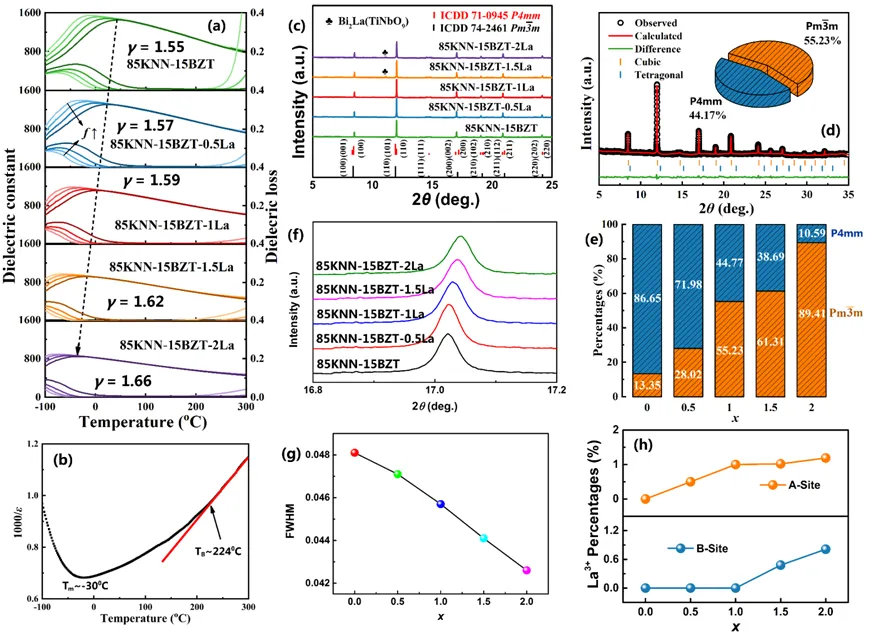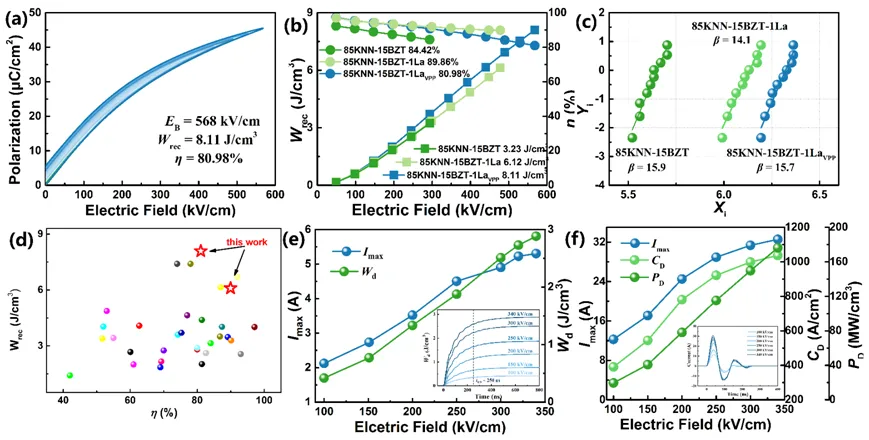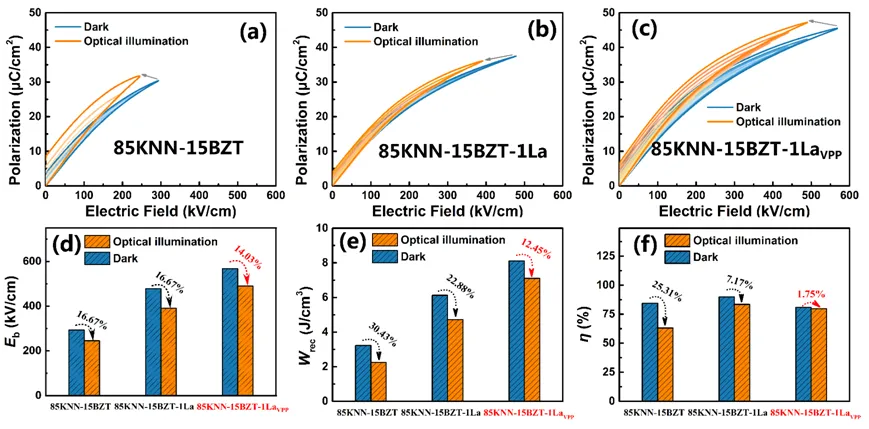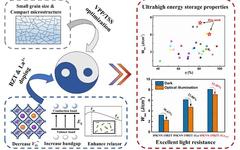
In recent years, the energy density and efficiency of dielectric energy storage ceramics with high operating voltage, fast charge-discharge capability, and good high-temperature stability have been continuously improved, showing great application potential in fields such as high-energy pulse power. Particularly, the development of relaxor ferroelectrics has further accelerated the application progress of dielectric energy storage ceramics, as relaxor ferroelectrics exist in the form of nano-polarized micro-regions within the dielectric constant’s highest temperature and Burns temperature ranges. They can respond quickly under the influence of an external electric field and return to their initial state rapidly when the external electric field is removed. Most current research is focused on how to improve the energy density of dielectric ceramics, which is indeed very important. However, for dielectric energy storage ceramics to move towards application, stable electrical performance under harsh environments, such as light irradiation, external pressure, and high temperatures, is also crucial.
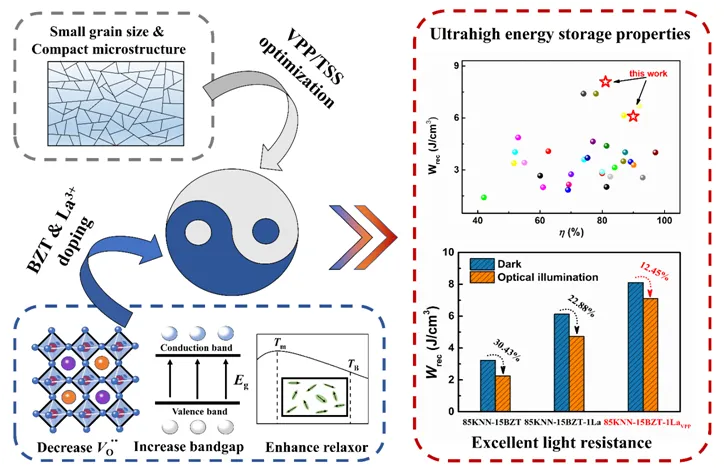 Figure 1: Multi-strategy Collaborative Optimization of KNN-Based Lead-Free Dielectric Ceramics’ Energy Storage Properties and Resistance to Light Fatigue
This research mainly focuses on the high energy storage and resistance to light fatigue characteristics of lead-free energy storage dielectric ceramics. By component and structural design, the energy storage stability of dielectric ceramics under light irradiation is improved. This paper introduces Bi(Zn0.5Ti0.5)O3 solid solution and La ions into (K0.5Na0.5)NbO3 ceramics, constructing a super-paraelectric relaxor image within the ceramics, increasing the band gap width of the system, and reducing the concentration of oxygen vacancies in the ceramics. Through the rolling film process and two-step sintering, the density, chemical homogeneity, and grain size of the ceramics are improved. The energy storage properties and light fatigue resistance of the ceramics are comprehensively optimized. Through component optimization and structural design, the energy storage density of the ceramics reaches 8.11 J/cm3, energy storage efficiency reaches 80.98%, and breakdown field strength reaches 568 kV/cm, which is higher than other reported lead-free dielectric ceramic systems based on sodium potassium niobate. More importantly, due to the extremely low concentration of oxygen vacancies in the ceramics, under 500W xenon lamp irradiation, the reduction rates of energy storage density and efficiency are only 12.45% and 1.75%, respectively. The excellent energy storage properties and resistance to light fatigue will accelerate the industrial application of lead-free dielectric ceramics.
Figure 2: (a) Dielectric Temperature Spectrum of 85KNN–15BZT–xLa Ceramics; (b) Burns Temperature MLCA Structural Schematic of 85KNN–15BZT–1La Sample; (c) Synchrotron Radiation XRD Spectrum of 85KNN–15BZT–xLa Ceramics; (d) Refined Synchrotron Radiation XRD Spectrum of 85KNN–15BZT–1La Sample; (e) Phase Proportion Distribution of 85KNN–15BZT–xLa Ceramics; (f) Enlarged Synchrotron Radiation XRD Spectrum of 85KNN–15BZT–xLa Samples; (g) Half-Width of (200) Diffraction Plane of 85KNN–15BZT–xLa Samples; (h) Distribution of La Ions in the Lattice.
Through dielectric temperature spectrum and synchrotron radiation XRD analysis, it can be seen that all samples of 85KNN–15BZT–xLa are in a coexistence state of pseudo-cubic and tetragonal phases, and the Burns temperature of the 85KNN–15BZT–1La sample is 224 °C, with the highest dielectric constant temperature at -30 °C, indicating that the sample is in a super-paraelectric state at room temperature. The refined XRD shows that as the La doping content increases, the half-width decreases, indicating reduced anisotropy. When x=1, the ratio of the two phases is roughly equal. As the La doping content increases, the position of the XRD peaks shifts to higher angles, indicating that La doping enters the lattice. The refinement also shows that La first occupies the A-site, and after the solubility of the A-site reaches saturation, it then occupies the B-site.
Figure 1: Multi-strategy Collaborative Optimization of KNN-Based Lead-Free Dielectric Ceramics’ Energy Storage Properties and Resistance to Light Fatigue
This research mainly focuses on the high energy storage and resistance to light fatigue characteristics of lead-free energy storage dielectric ceramics. By component and structural design, the energy storage stability of dielectric ceramics under light irradiation is improved. This paper introduces Bi(Zn0.5Ti0.5)O3 solid solution and La ions into (K0.5Na0.5)NbO3 ceramics, constructing a super-paraelectric relaxor image within the ceramics, increasing the band gap width of the system, and reducing the concentration of oxygen vacancies in the ceramics. Through the rolling film process and two-step sintering, the density, chemical homogeneity, and grain size of the ceramics are improved. The energy storage properties and light fatigue resistance of the ceramics are comprehensively optimized. Through component optimization and structural design, the energy storage density of the ceramics reaches 8.11 J/cm3, energy storage efficiency reaches 80.98%, and breakdown field strength reaches 568 kV/cm, which is higher than other reported lead-free dielectric ceramic systems based on sodium potassium niobate. More importantly, due to the extremely low concentration of oxygen vacancies in the ceramics, under 500W xenon lamp irradiation, the reduction rates of energy storage density and efficiency are only 12.45% and 1.75%, respectively. The excellent energy storage properties and resistance to light fatigue will accelerate the industrial application of lead-free dielectric ceramics.
Figure 2: (a) Dielectric Temperature Spectrum of 85KNN–15BZT–xLa Ceramics; (b) Burns Temperature MLCA Structural Schematic of 85KNN–15BZT–1La Sample; (c) Synchrotron Radiation XRD Spectrum of 85KNN–15BZT–xLa Ceramics; (d) Refined Synchrotron Radiation XRD Spectrum of 85KNN–15BZT–1La Sample; (e) Phase Proportion Distribution of 85KNN–15BZT–xLa Ceramics; (f) Enlarged Synchrotron Radiation XRD Spectrum of 85KNN–15BZT–xLa Samples; (g) Half-Width of (200) Diffraction Plane of 85KNN–15BZT–xLa Samples; (h) Distribution of La Ions in the Lattice.
Through dielectric temperature spectrum and synchrotron radiation XRD analysis, it can be seen that all samples of 85KNN–15BZT–xLa are in a coexistence state of pseudo-cubic and tetragonal phases, and the Burns temperature of the 85KNN–15BZT–1La sample is 224 °C, with the highest dielectric constant temperature at -30 °C, indicating that the sample is in a super-paraelectric state at room temperature. The refined XRD shows that as the La doping content increases, the half-width decreases, indicating reduced anisotropy. When x=1, the ratio of the two phases is roughly equal. As the La doping content increases, the position of the XRD peaks shifts to higher angles, indicating that La doping enters the lattice. The refinement also shows that La first occupies the A-site, and after the solubility of the A-site reaches saturation, it then occupies the B-site.
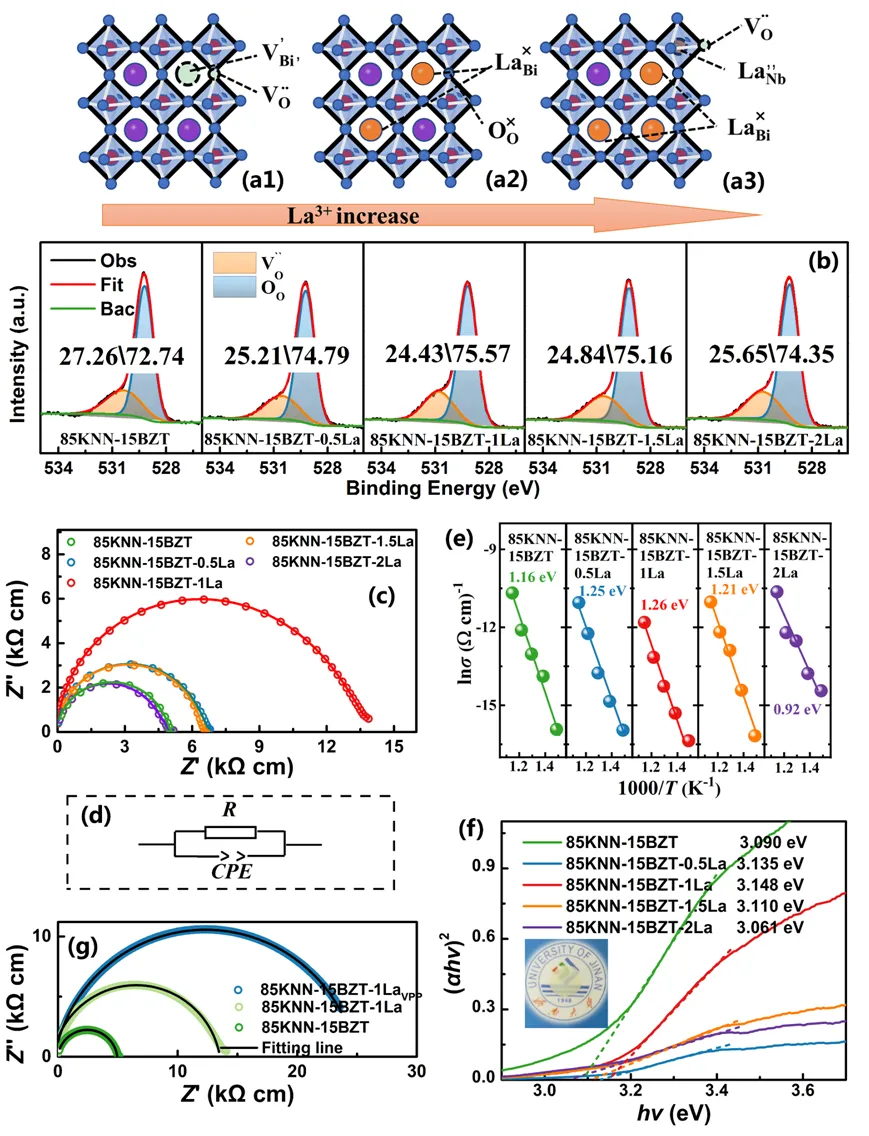 Figure 3: (a) Schematic Diagram of La Occupation and Defect Structure as Doping Amount Increases; (b) XPS Schematic of O and Fitted Concentration of Oxygen Vacancies; (c) Impedance Spectrum of 85KNN–15BZT–xLa Ceramics; (d) Fitting Circuit Diagram of Impedance Spectrum; (e) Arrhenius Fitting Diagram of Conductivity; (f) Absorption Spectrum of 85KNN–15BZT–xLa Samples; (g) Impedance Spectrum and Corresponding Fitting Diagram of 85KNN–15BZT, 85KNN–15BZT–1La, and 85KNN–15BZT–1LaVPP Samples.
Through XRD refinement, analysis of La occupation, defect chemistry theory, band gap width measurement, impedance spectrum analysis, and XPS oxygen vacancy concentration analysis, it can be confirmed that as the La content increases, the concentration of oxygen vacancies first decreases and then increases, reaching the lowest at x=1. Therefore, the electrical resistance of x=1 ceramics also reaches the highest, significantly increasing the breakdown field strength of the ceramics and favoring the increase of energy storage density. Further comparison of the impedance spectra of 85KNN–15BZT, 85KNN–15BZT–1La, and 85KNN–15BZT–1LaVPP samples shows that when using the rolling film process, the resistance of the ceramics is further enhanced.
Figure 3: (a) Schematic Diagram of La Occupation and Defect Structure as Doping Amount Increases; (b) XPS Schematic of O and Fitted Concentration of Oxygen Vacancies; (c) Impedance Spectrum of 85KNN–15BZT–xLa Ceramics; (d) Fitting Circuit Diagram of Impedance Spectrum; (e) Arrhenius Fitting Diagram of Conductivity; (f) Absorption Spectrum of 85KNN–15BZT–xLa Samples; (g) Impedance Spectrum and Corresponding Fitting Diagram of 85KNN–15BZT, 85KNN–15BZT–1La, and 85KNN–15BZT–1LaVPP Samples.
Through XRD refinement, analysis of La occupation, defect chemistry theory, band gap width measurement, impedance spectrum analysis, and XPS oxygen vacancy concentration analysis, it can be confirmed that as the La content increases, the concentration of oxygen vacancies first decreases and then increases, reaching the lowest at x=1. Therefore, the electrical resistance of x=1 ceramics also reaches the highest, significantly increasing the breakdown field strength of the ceramics and favoring the increase of energy storage density. Further comparison of the impedance spectra of 85KNN–15BZT, 85KNN–15BZT–1La, and 85KNN–15BZT–1LaVPP samples shows that when using the rolling film process, the resistance of the ceramics is further enhanced.
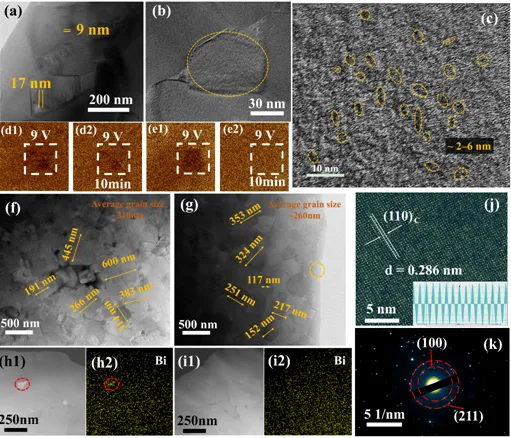 Figure 4: (a) TEM Photos of Electric Domains of 85KNN–15BZT, (b) 85KNN–15BZT–1La, and (c) 85KNN–15BZT–1LaVPP Samples; (d) PFM Images of 85KNN–15BZT and (e) 85KNN–15BZT–1La; (f) Bright Field Images of 85KNN–15BZT–1La and (g) 85KNN–15BZT–1LaVPP Samples; (h) EDS Mapping of 85KNN–15BZT–1La and (i) 85KNN–15BZT–1LaVPP Samples; (j) High-Resolution TEM and (k) SAED Patterns of 85KNN–15BZT–1LaVPP Samples.
Through TEM characterization, it can also be seen that the electric domain sizes of 85KNN–15BZT, 85KNN–15BZT–1La, and 85KNN–15BZT–1LaVPP samples gradually decrease, indicating that the domain flipping becomes easier. PFM also confirms that 85KNN–15BZT–1La has easier domain flipping and recovery than the 85KNN–15BZT sample. TEM and energy spectrum analysis confirm that the 85KNN–15BZT–1LaVPP sample has higher density and more uniform composition than the 85KNN–15BZT–1La sample. Additionally, the 85KNN–15BZT–1LaVPP sample exhibits very high crystallinity.
Figure 5: (a) P-E Curve of 85KNN–15BZT–1LaVPP Sample; (b) Variation of Energy Storage Properties with Voltage and (c) Weber Distribution Curve of 85KNN–15BZT, 85KNN–15BZT–1La, and 85KNN–15BZT–1LaVPP Samples; (d) Comparison of Energy Storage Density and Efficiency of Current Work Samples with Other Dielectric Ceramics; (e) Over-Damped and (f) Under-Damped Discharge Curves of 85KNN–15BZT–1LaVPP Sample.
Figure 6: (a) Comparison of P-E Curves of 85KNN–15BZT, (b) 85KNN–15BZT–1La, and (c) 85KNN–15BZT–1LaVPP Samples under Darkness and Illumination; (d) Comparison of Breakdown Field Strength, (e) Energy Storage Density, and (f) Energy Storage Efficiency.
Figure 4: (a) TEM Photos of Electric Domains of 85KNN–15BZT, (b) 85KNN–15BZT–1La, and (c) 85KNN–15BZT–1LaVPP Samples; (d) PFM Images of 85KNN–15BZT and (e) 85KNN–15BZT–1La; (f) Bright Field Images of 85KNN–15BZT–1La and (g) 85KNN–15BZT–1LaVPP Samples; (h) EDS Mapping of 85KNN–15BZT–1La and (i) 85KNN–15BZT–1LaVPP Samples; (j) High-Resolution TEM and (k) SAED Patterns of 85KNN–15BZT–1LaVPP Samples.
Through TEM characterization, it can also be seen that the electric domain sizes of 85KNN–15BZT, 85KNN–15BZT–1La, and 85KNN–15BZT–1LaVPP samples gradually decrease, indicating that the domain flipping becomes easier. PFM also confirms that 85KNN–15BZT–1La has easier domain flipping and recovery than the 85KNN–15BZT sample. TEM and energy spectrum analysis confirm that the 85KNN–15BZT–1LaVPP sample has higher density and more uniform composition than the 85KNN–15BZT–1La sample. Additionally, the 85KNN–15BZT–1LaVPP sample exhibits very high crystallinity.
Figure 5: (a) P-E Curve of 85KNN–15BZT–1LaVPP Sample; (b) Variation of Energy Storage Properties with Voltage and (c) Weber Distribution Curve of 85KNN–15BZT, 85KNN–15BZT–1La, and 85KNN–15BZT–1LaVPP Samples; (d) Comparison of Energy Storage Density and Efficiency of Current Work Samples with Other Dielectric Ceramics; (e) Over-Damped and (f) Under-Damped Discharge Curves of 85KNN–15BZT–1LaVPP Sample.
Figure 6: (a) Comparison of P-E Curves of 85KNN–15BZT, (b) 85KNN–15BZT–1La, and (c) 85KNN–15BZT–1LaVPP Samples under Darkness and Illumination; (d) Comparison of Breakdown Field Strength, (e) Energy Storage Density, and (f) Energy Storage Efficiency.
Through performance discovery, the energy storage density of 85KNN–15BZT–1LaVPP ceramics reaches 8.11 J/cm3, energy storage efficiency reaches 80.98%, and breakdown field strength reaches 568 kV/cm, which is higher than other reported lead-free dielectric ceramic systems based on sodium potassium niobate. More importantly, due to the extremely low concentration of oxygen vacancies within the ceramics, under 500W xenon lamp irradiation, the reduction rates of energy storage density and efficiency are only 12.45% and 1.75%, respectively. The excellent energy storage properties and resistance to light fatigue will accelerate the industrial application of lead-free dielectric ceramics.
Paper Link:
https://www.sciopen.com/article/10.26599/JAC.2024.9220833
(Click the bottom left corner “Read the original text” to go directly to the original text)
For submissions, reprints, and collaborations, please contact WeChat:MatResFron001
Banner | Promotion
Welcome to leave comments and share your views.Support the author, light up the bottom right corner “Like” and “Looking”↓↓↓


